Iceland’s Hot Springs: Geothermal Gems in the Land of Fire and Ice
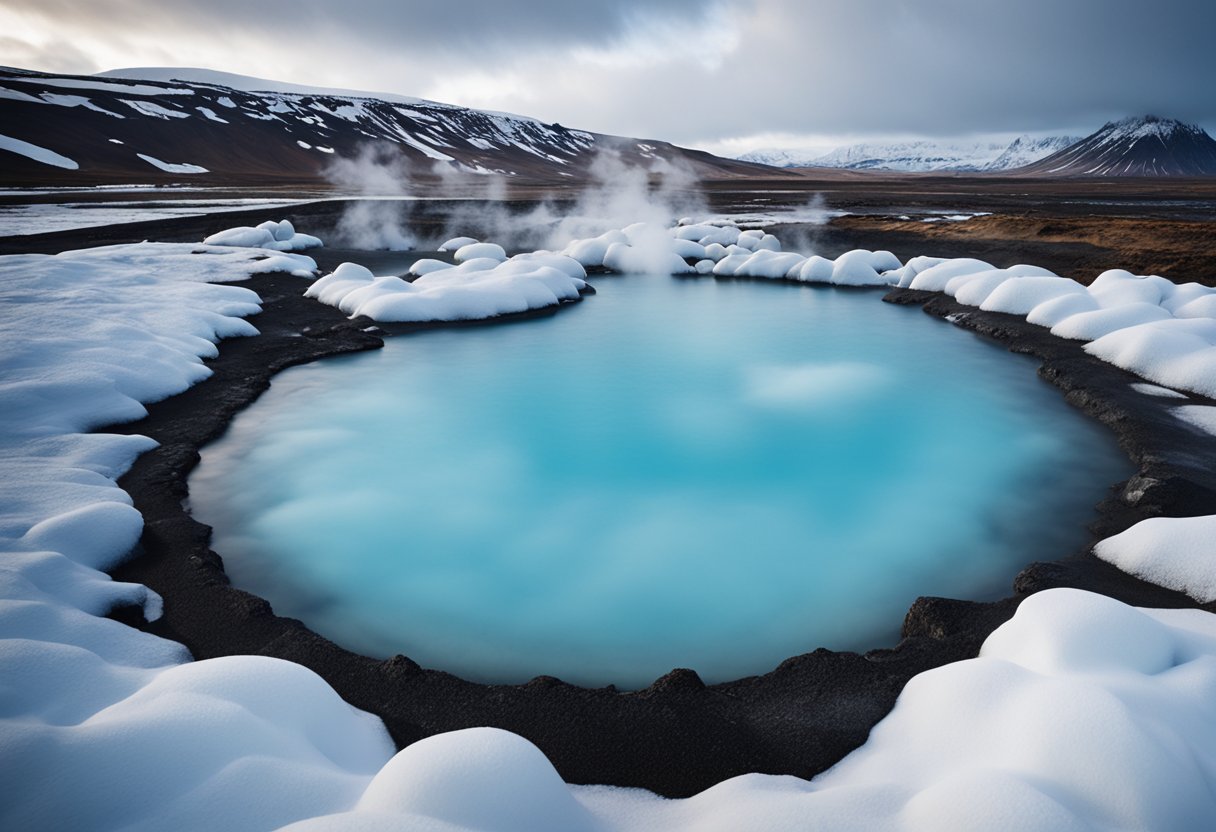
Updated On: April 22, 2024 by Raghda Elsabbagh
Nestled in the dramatic landscapes of Iceland, the land of fire and ice, are the geothermal wonders known as hot springs. These natural sanctuaries are a testament to the island’s volcanic activity, offering both tranquillity and a unique connection to the Earth’s power. Iceland is a country where the forces of nature conspire to create an environment that is as challenging as it is beautiful, and the hot springs are but one example of the natural splendour found here.

As we traverse this rugged terrain, we find that each geothermal pool, from the famed Blue Lagoon to the more secluded springs dotting the countryside, tells a story of geology, history, and culture. They provide a sanctuary for relaxation and reflection, allowing visitors to bask in warm, mineral-rich waters while surrounded by Iceland’s breathtaking scenery. These hot springs are more than just a visitor attraction; they represent an integral part of Icelandic life, serving as communal hubs where locals and tourists alike can soak away the stresses of the day.
Table of Contents
Exploring the Wonders of Icelandic Geothermal Pools
We invite you on a journey through the steamy, enchanting landscape of Iceland’s geothermal pools. From their historical roots to the world-famous Blue Lagoon, each pool is a testament to the island’s volcanic heartbeat.
The History and Science of Geothermal Energy in Iceland
Iceland sits atop a veritable furnace of volcanic activity, which gifts us an abundance of geothermal energy. This natural resource has been utilised for centuries, with the earliest settlers harnessing the hot water for warmth and bathing. Modern Iceland continues this tradition by using geothermal energy for electricity and heating, making it a world leader in renewable energy sources.
Discovering the Famous Blue Lagoon
One cannot speak of Icelandic geothermal pools without mentioning the iconic Blue Lagoon. Nestled in a lava field in Grindavík on the Reykjanes Peninsula, this geothermal spa is renowned for its mineral-rich waters, believed to have skin-healing properties. Its milky-blue water and steamy surrounds create a surreal, otherworldly ambience, making it a must-visit destination.
Secret Lagoon and Lesser-Known Havens
For those seeking quieter, more intimate experiences, Iceland’s oldest geothermal pool, the Secret Lagoon, offers a tranquil escape. Built in 1891, it retains its historic charm while providing the warm comforts of geothermal waters. There are numerous lesser-known geothermal pools scattered across the island, offering serene respite away from crowded tourist spots.
Geosea and the Unique Geothermal Sea Baths
In the north, the Geosea Geothermal Sea Baths offer an unparalleled experience. These sea baths combine geothermal heat with ocean water, providing a spa experience with spectacular views of Skjálfandi Bay. Bathing in these geothermal waters as you gaze upon the majestic Icelandic scenery is an indulgence like no other.
Our exploration demonstrates the diverse array of geothermal experiences available in Iceland, each pool providing a unique window into the geothermal heart of this volcanic island.
The Natural Hot Springs of Iceland’s Diverse Regions
Iceland, famed for its volcanic landscape, plays host to some of the world’s most magnificent natural hot springs. These geothermal waters, found across the country’s varied regions, offer visitors unique opportunities to immerse themselves in restorative warmth amidst rugged beauty.
Reykjadalur and the South’s Steamy Retreats
Reykjadalur, or ‘Steam Valley’, is a fascinating geothermal area just a short hike from Hveragerði in the south of Iceland. Here, the warm river water makes for an extraordinary bathing experience against a backdrop of stunning green valleys and steam vents. The South of Iceland is also home to other lesser-known hot springs, offering serenity and a connection with nature away from the usual tourist trails.
The Westfjords’ Remote Geothermal Escapes
Moving further to the untouched and sparsely populated Westfjords, visitors will find themselves in a realm of profound tranquillity. The natural hot springs in this region, such as Hellulaug, are remote and offer a sense of solitude that is hard to match. These geothermal gems are tucked away in the rugged cliffs and provide a haven where one can soak while contemplating the vast Arctic Ocean.
Mývatn Nature Baths and the North’s Treasures
In contrast to the solitude of the Westfjords, the Mývatn Nature Baths in North Iceland is a more social but equally picturesque geothermal area. The waters here are rich in minerals and draw visitors looking for both relaxation and skin therapy. The North’s treasures don’t end there, with numerous other natural hot springs dotted around the landscape, each providing its unique Nordic spa experience amidst the dramatic backdrop of Iceland’s untamed wilderness.
Leisure and Wellness in Icelandic Hot Springs
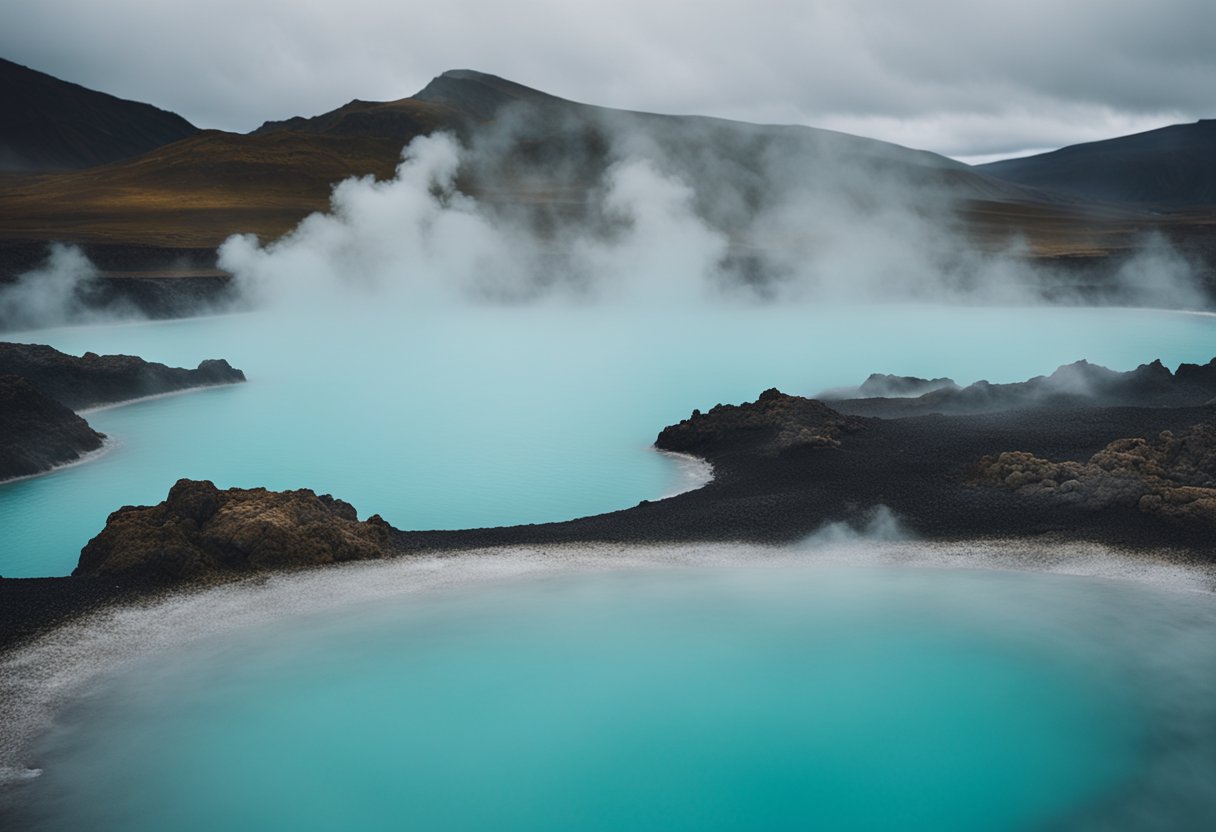
Icelandic hot springs offer a unique fusion of leisure and wellness, encapsulated in the enchanting settings of the island’s geothermal landscapes. From the mineral-rich waters believed to have therapeutic properties to the opulence of onsite spa facilities, visitors can indulge in a relaxing retreat that caters to both physical and mental rejuvenation.
Health Benefits of Geothermal Waters
The geothermal springs of Iceland are famous for their high mineral content, particularly silica, sulphur, and other elements beneficial to the skin and body. Bathing in these waters is believed to aid in alleviating conditions such as psoriasis and eczema, while the heat itself can help reduce muscle tension and promote relaxation. Studies have indicated that natural hot water can improve circulation and provide a natural method of stress relief.
Pampering with Onsite Spa and Massage Services
Many Icelandic hot springs have expanded their offerings to include a range of onsite spa and massage services, each designed to enhance the visitor’s sense of wellness. For instance, guests might find options such as deep tissue massages to alleviate muscle strain or aromatherapy sessions for holistic well-being. Additionally, facilities such as saunas and steam rooms contribute to the overall spa experience, allowing for a complete detoxification process in a serene environment.
Iceland’s Hot Springs Through the Seasons
In Iceland, the geothermal activity heats up a unique experience each season. Whether basking under the summer’s midnight sun or unwinding in the winter with a view of the Auroras, the hot springs are a testament to Iceland’s natural wonders.
Bathing Under the Midnight Sun and Summer Skies
During the summer months, the midnight sun graces the Icelandic skies, allowing for extended days and a unique opportunity to soak in the warmth of the hot springs under a never-setting sun. This phenomenon provides an almost otherworldly backdrop for a swim in places like Sky Lagoon, where the merging of the ocean and geothermal warmth can be indulged in synergy with extended daylight.
Winter Soaks with Northern Lights Views
The winter season brings a different kind of magic to Iceland’s hot springs. Imagine drifting in the geothermally heated waters with the spectacle of the Northern Lights dancing overhead. There’s something profoundly calming about the juxtaposition of the chilly winter air and the steamy embrace of hot springs like those at Hvammsvik. The Aurora’s glow reflecting on the water’s surface enhances the visceral experience of Iceland’s winters.
Outdoor Adventure and Activities Near Geothermal Sites
Iceland’s geothermal sites are not just a haven for relaxation—they are also gateways to outdoor adventures that celebrate the island’s dramatic natural beauty. Here, we invite you to experience activities that captivate your senses and challenge your spirit.
Hiking and Exploring the Rugged Icelandic Landscape
The terrain surrounding Iceland’s hot springs offers abundant hiking opportunities. Each trail presents its own array of wonders, from steaming vents and bubbling mud pots to remarkable mountain vistas. For those inclined towards adventure, trails such as those around the Hvammsvik Hot Springs not only lead you through magnificent landscapes but also enable you to steep in the warmth of geothermal waters post-hike.
- Prepare for a hike: To ensure a safe and enjoyable hike, it’s vital to have the right gear, such as waterproof clothing and sturdy walking boots.
Wildlife Encounters and Whale Watching in Nearby Waters
Whale watching near geothermal sites allows for unique encounters with marine life in their natural habitat. In areas like the nearby fjord of Hvalfjordur, sometimes referred to during wildlife excursions, one may witness the awe-inspiring sight of whales cutting through the icy waters, only a stone’s throw from the warmth of Iceland’s famed hot springs.
- Respect the wildlife: Always maintain a safe and respectful distance from whales and other wildlife to ensure their natural behaviour is not disturbed by our presence.
Cultural Insights and Local Experiences
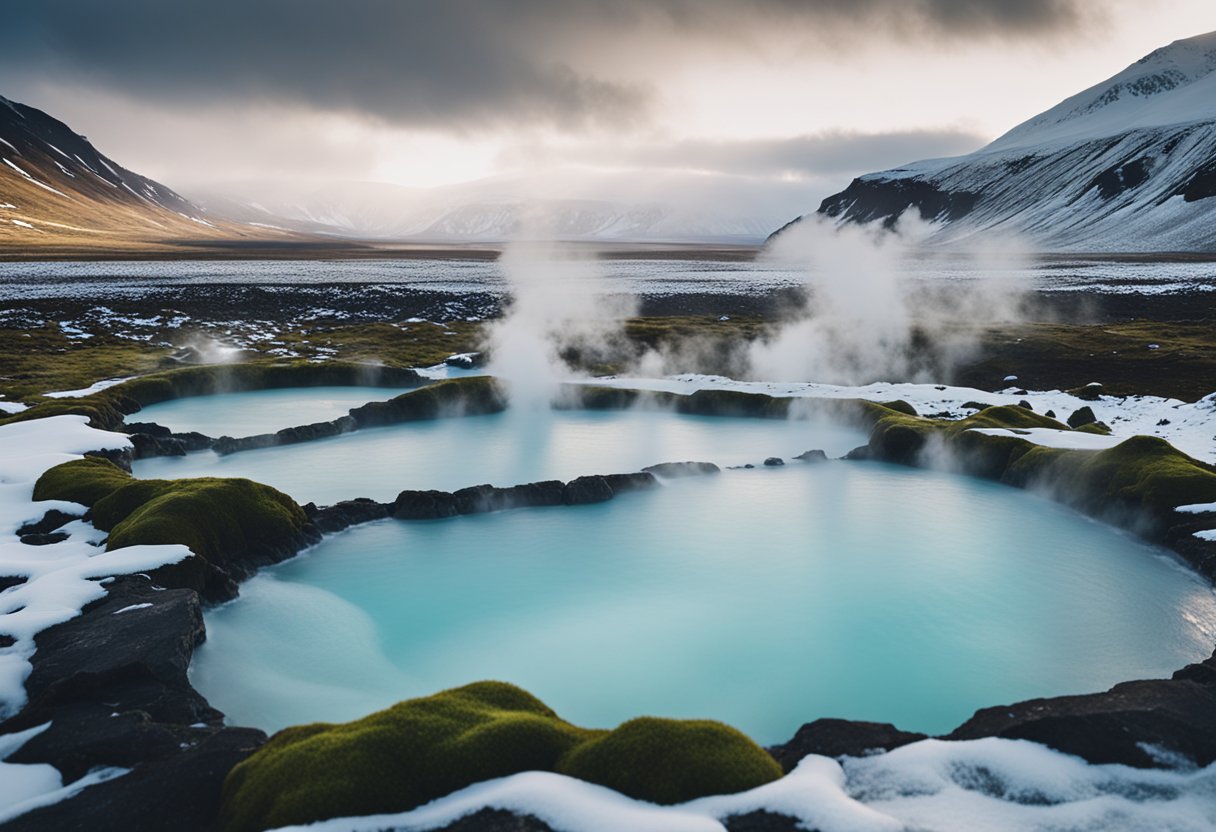
Venturing into the heart of Iceland’s geothermal culture reveals a rich tapestry of local customs and refined culinary experiences. Let’s immerse ourselves in the traditions and tastes that define the Icelandic hot spring scene.
Icelandic Traditions and the Etiquette of Public Bathing
We find that one of the integral parts of Icelandic culture is the communal enjoyment of hot springs, which are as much about socialising as they are about relaxation. When visiting geothermal pools, respecting local customs is paramount. It’s expected that before slipping into the soothing waters, we all follow a thorough routine in the changing rooms. This entails taking a shower without swimwear to maintain the cleanliness of the pools, which are often free from chlorine.
In many local spots, as detailed in a feature by National Geographic, the experience of the hot springs is deeply intertwined with the surrounding wild landscape. Conversing with locals here can enrich our understanding of Iceland and its culture.
Culinary Delights at Hot Spring Resorts
Adjacent to the warmth and wellness of hot springs, we often find restaurants that provide an authentic taste of Iceland. These establishments typically serve dishes that showcase local ingredients crafted with traditional Icelandic cooking techniques. From freshly caught Arctic char to geothermally baked bread, the food complements the geothermal experience by warming us from the inside out.
Logistical Information for Visiting Hot Springs
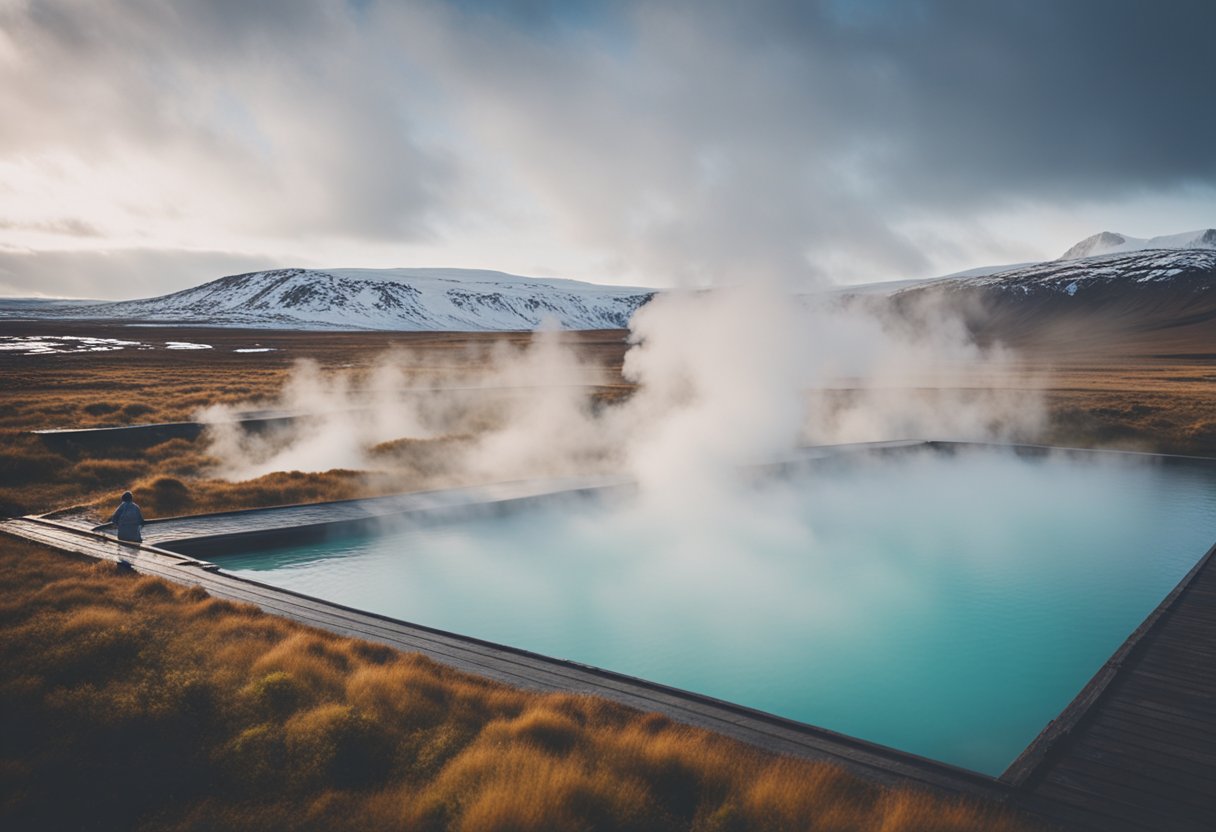
When planning a visit to Iceland’s renowned hot springs, it’s important to consider the logistics, from access issues on private land to nearby accommodations. We’ll navigate you through this to ensure a smooth and enjoyable visit.
Access and Private Land Considerations
In Iceland, many hot springs are situated on private properties, and care should be taken to respect landowner rights and the local environment. The Hvammsvik Hot Springs is located on a private estate, so ensuring you have proper access permissions is crucial in preserving the harmonious balance between tourism and local land use. Similarly, the iconic Blue Lagoon is privately owned and requires advance booking.
Secure your access by:
- Booking in advance where required
- Adhering strictly to designated paths and areas
- Paying any required entrance fees
Remember that venturing onto private land without permission is not just frowned upon; it can also have legal consequences. The Ring Road (Route 1) offers convenient travel around Iceland, but always check which hot springs require a fee or pre-arranged visit, particularly as you journey North towards Akureyri, where the geothermal activity also promises exquisite springs to enjoy.
Accommodations and Staying Near the Springs
We recommend staying close to the hot springs to maximise your relaxation time and minimise travel. Whether it’s a cabin in the mountains near Akureyri or a hotel close to the hot springs near Reykjavík, you’ll find a range of accommodations to suit varying budgets and preferences:
- Reykjavík: Capital city with a large selection of hotels
- Ring Road: Find cabins and guesthouses close to roadside springs
- Rural Areas: Guesthouses, cabins, and local accommodations offer a more intimate experience
The cabin stays can be quite memorable, embedding you within the Icelandic landscape and providing a unique experience of seclusion and connection with nature. It’s often better to book accommodations near the hot springs well in advance, especially during peak tourist seasons.
Family-Friendly and Accessible Geothermal Pools
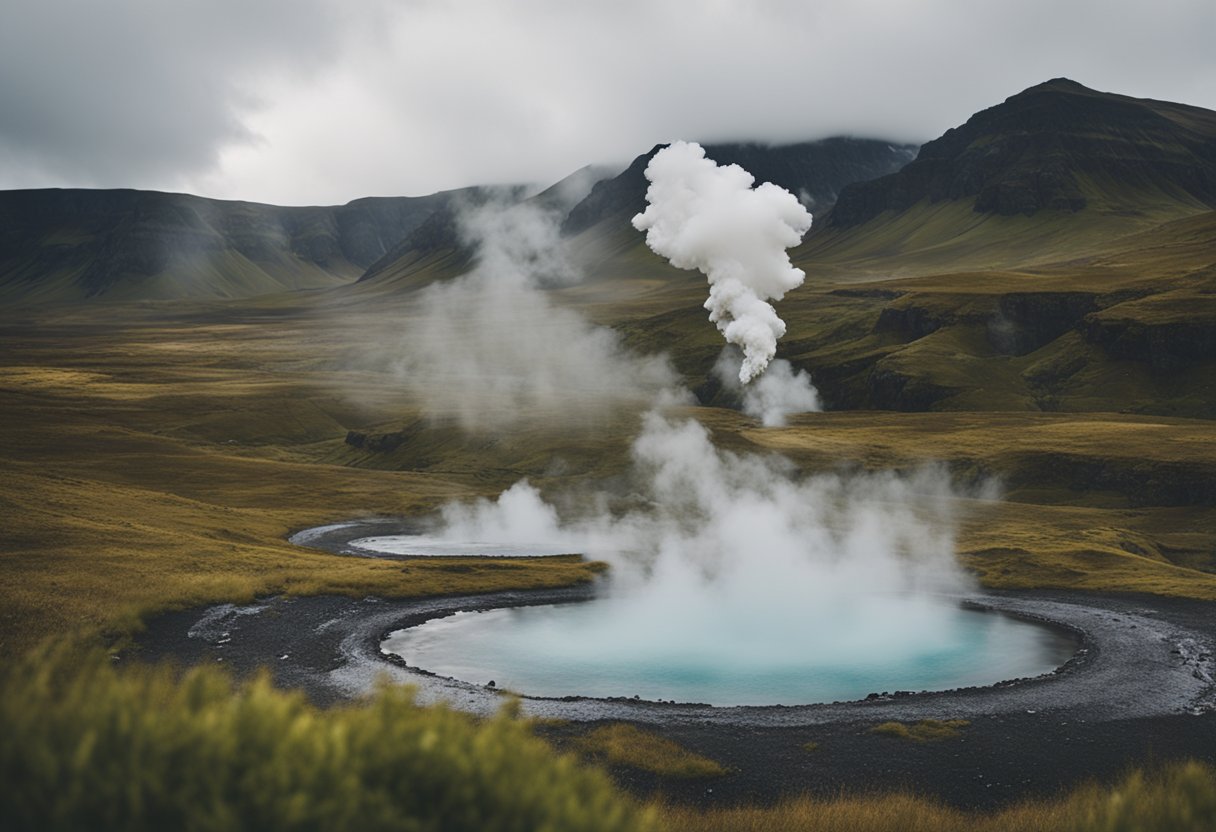
We understand that when travelling with family, it’s important to select destinations that are suitable for all ages. Iceland’s geothermal pools offer a warm oasis against the cool climate, providing an ideal setting for a family outing. Below, we detail how these geothermal treasures cater to visitors of all generations, ensuring a comfortable and enjoyable experience.
Hot Springs for Children and Elderly Visitors
When considering a geothermal pool for children and elderly visitors, safety and accessibility are paramount. Many of Iceland’s geothermal pools boast zero-entry designs, making them easily accessible for elderly visitors or those with mobility issues.
- Temporarily Controlled Areas
Certain pools maintain sections with lower temperatures, which is ideal for children who are sensitive to heat or elderly individuals who need a milder environment. This allows them to enjoy the therapeutic benefits of geothermal water without discomfort. - Family Amenities
Facilities such as changing rooms and lockers are often available with family-friendly amenities, which include baby-changing stations and wheelchair-accessible facilities to ensure a stress-free visit. - Supervised Swimming Areas
Pools like the modern outdoor bathing complex at Krauma feature supervised swimming areas where families can enjoy multi-temperature hot pots and steam baths with peace of mind.
By offering amenities that cater to visitors of all ages, Iceland’s geothermal pools exemplify family-friendly recreation while embracing the intrinsic beauty of the country’s geothermal activity.
Conservation and Sustainability of Iceland’s Hot Springs
Iceland’s hot springs are not just tourist attractions; they play a crucial role in the nation’s commitment to environmental stewardship and sustainable living.
Environmental Impact and Protection Efforts
The geothermal heat powering Iceland’s hot springs is a bountiful resource that requires mindful conservation to maintain the delicate balance of nature. We recognise that natural pools and geothermal sites, if left unprotected, can suffer from overuse and environmental degradation. To combat this, concerted efforts are made to ensure the sustainability of these geothermal gems.
Active conservation strategies include the careful monitoring of geothermal activity, strict regulations on land use, and the implementation of visitor guidelines to limit human impact. By instituting measures like designated pathways and controlled access to sensitive areas, we help preserve the integrity of our natural pools.
In terms of sustainability, Iceland harnesses geothermal heat not only for its natural pools but also for eco-friendly heating and electricity, reducing the nation’s carbon footprint. Geothermal plants, such as those highlighted by Iceland’s innovations to reach net zero, are at the forefront of this initiative.
Our protection efforts often involve local communities and environmental organizations. These entities work collaboratively to educate the public, protect ecosystems, and ensure that the utilisation of geothermal resources does not compromise future generations’ ability to enjoy them.
Through this multi-faceted approach to environmental impact and protection, we safeguard the vitality of Iceland’s hot springs, ensuring they remain a sustainable resource for all.
Closing Thoughts on Iceland’s Geothermal Treasures
As we reflect on the geothermal marvels of Iceland, it’s evident that these natural wonders offer more than just a stunning visual spectacle. The hot springs scattered across this volcanic land provide visitors with an unparalleled sense of peace and relaxation. Iceland’s ability to harness this geothermal energy underlines the nation’s innovation and respect for the environment.
- Peace: The tranquil surroundings of the geothermal areas are a sanctuary for those seeking calm.
- Relaxation: Warm waters rich in minerals offer a natural spa experience, soothing both body and mind.
The hot springs are more than tourist attractions; they are integral to the Icelandic way of life. These geothermal gems heat homes and public spaces, illustrating a harmony between civilisation and nature.
Our journey through Iceland’s steamy landscapes reminds us that the earth offers gifts that can be both utilised and admired. From the iconic Blue Lagoon to lesser-known hot springs, the country’s geothermal energy is a testament to the strength lying within its serene—and sometimes stark—scenery.
Iceland serves as an incredible example of how nations can thrive by embracing their natural resources without disturbing the delicate balance of the environment. As we leave these geothermal treasures behind, we carry with us a deeper appreciation for Iceland’s commitment to sustainable living and the quiet majesty of its landscapes.
Frequently Asked Questions
In this section, we answer some of the most common inquiries about Iceland’s geothermal hot springs, giving you clear and practical information to enhance your experience.
What criteria determine the best hot springs to visit in Iceland?
The best hot springs to visit in Iceland are often judged by accessibility, natural setting, and water quality. Additional facilities and the overall atmosphere of the location can further influence visitor experience. For instance, Hvammsvík Hot Springs are praised for their blend of land and sea, offering a unique thermal bathing experience.
How has Iceland’s geological activity contributed to the formation of its geothermal hot springs?
Iceland’s position on the Mid-Atlantic Ridge means it’s a hotbed of volcanic activity, which has been critical in forming the numerous geothermal springs across the country. The natural geothermal energy results from the interaction between volcanic activity and Iceland’s abundant water sources, heating the water naturally before it surfaces.
In which regions of Iceland are the most renowned geothermal pools located?
The most renowned geothermal pools are scattered throughout Iceland, with the South West home to famous spots like the Blue Lagoon and Secret Lagoon. The North has the Mývatn Nature Baths, while the Westfjords boast the historical Guðrúnarlaug pool.
Are there any health benefits associated with bathing in Iceland’s geothermal springs?
Bathing in Iceland’s geothermal springs can offer several health benefits. The minerals found in geothermal water, such as sulphur, are believed to have skin-healing properties. Furthermore, the warm waters are known to relax muscles and alleviate stress.
What should one consider before going for a swim in Iceland’s wild hot springs?
Before going for a swim in wild hot springs, one should consider safety first. These natural pools lack safety measures, and sudden temperature changes can occur. It’s crucial to check the temperature before entering and also to be aware of the surrounding terrain and weather conditions.
Could you list some intriguing facts about the geothermal phenomena of Iceland’s hot springs?
Certainly, Iceland’s geothermal hot springs are a marvel of geology. For example, some pools can change temperature depending on geological shifts or weather patterns. Another interesting fact is that geothermal energy from such springs powers homes and businesses throughout Iceland, showcasing how the nation harnesses this natural resource.






